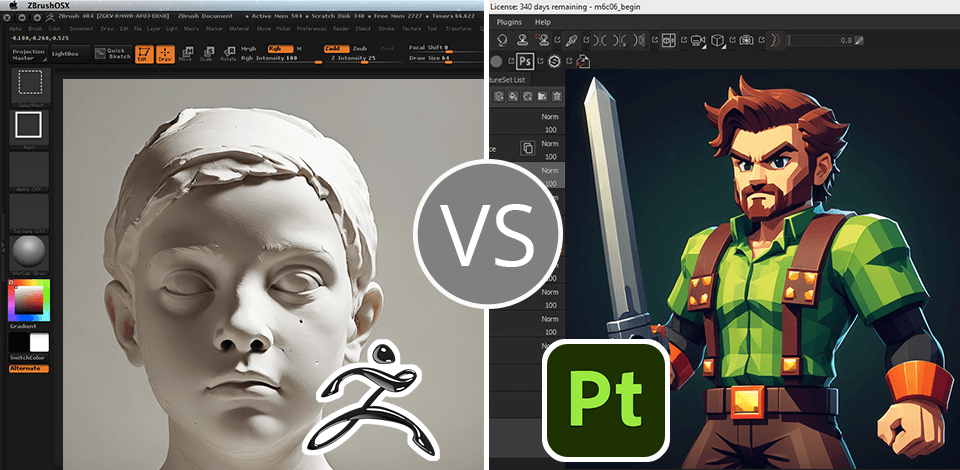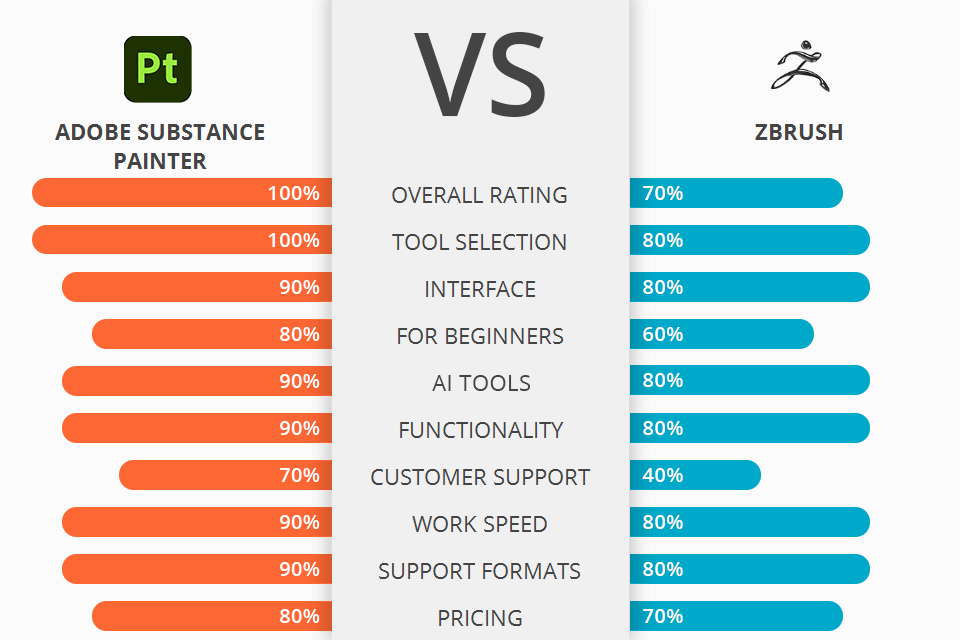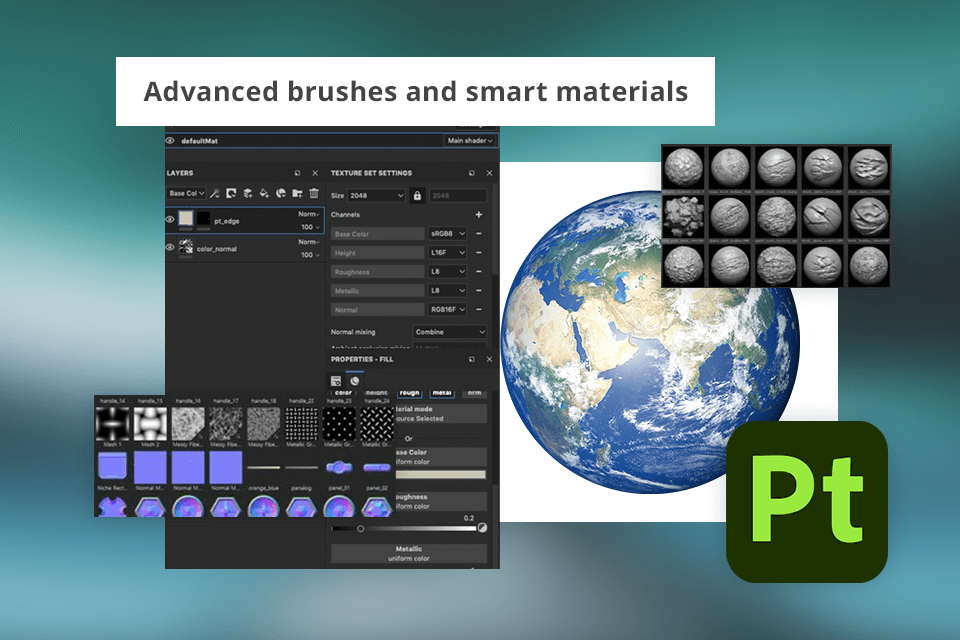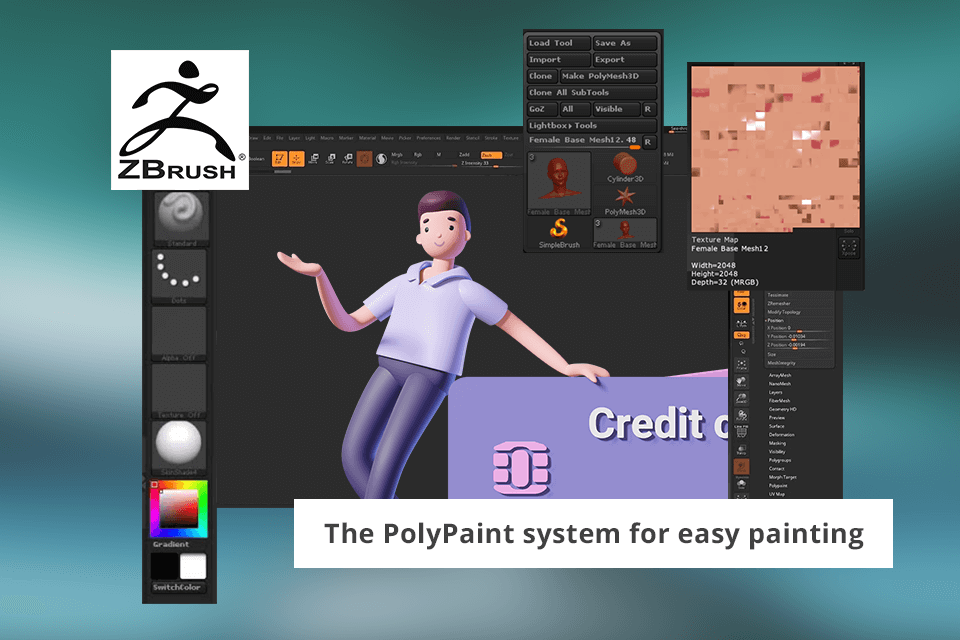
When I was creating 3D models of robots for a video game, I needed to use realistic textures. I decided to try several programs and compare Substance Painter vs ZBrush. With the help of Substance Painter, I created detailed and high-resolution textures of robots and houses to harmoniously fit into the general style of the game.
On the other hand, ZBrush is a more sophisticated tool with powerful sculpting capabilities. When I first started using the program, I was disappointed with the lengthy texturing and UV unwrapping process. Besides, I had to make many adjustments to achieve decent results.
For novice users looking for an efficient tool to start creating textures and materials, Substance Painter is a perfect fit. I like this program because of its functionality, intuitive UI, and compatibility with most 3D modeling programs and game engines.

|
|

Substance Painter
|

ZBrush
|
|
Rating |
★★★★☆ 4.5/5 |
★★★★☆ 4/5 |
|
Best For: |
Creating high-resolution textures and materials for lifelike surfaces |
Digital sculpting and creating detailed 3D models |
|
User Level |
Game developers and 3D artists of all levels |
Professional artists |
|
Free Trial |
✔️ |
✔️ |
|
Price |
$49.99/mo |
€43.05/mo |
|
Key Differences |
|
|
|
Features |
|
|

Substance Painter is an effective instrument for creating detailed and natural-looking textures. The program has an easy-to-understand UI and a powerful set of features, so even beginners can master it and use it effectively.
Besides, the software supports PBR materials and uses particle brushes to make textures deeper and more realistic. The ability to re-create visibility of A Daz Studio Genesis figure without trouble. Thanks to it, the textures are shown as if it is in one figure. This feature is unavailable in ZBrush. And I like that for creating 3D models I can use Adobe Substance 3D Modeler, so I don’t need any additional software.
When working in this program, I was disappointed with two things: I struggled with performance issues when creating complex textures and materials; this is a subscription-based tool, so monthly payments are a must.

ZBrush boasts excellent rendering capabilities and powerful sculpting brushes enabling users to develop highly detailed models. If you compare ZBrush and 3Ds Max, you’ll notice that ZBrush is a more advanced option and is a great solution for seasoned artists.
The subdivision methods used by Zbrush are not limited. Supporting UDIM workflow, the program is designed to be tightly connected with a professional CG pipeline be it a concept, illustration, or for the actual asset in-game or film.
Comparing Adobe Substance Painter vs ZBrush in terms of easiness of use, the second option is much more complicated. The program has a steep learning curve, so it is quite complicated to master. But its compatibility with Painter is a big advantage.
On the website, there is a package that includes all the tools in Maxon One (ZBrush is among them) and the Adobe Substance 3D Collection.
|
|

Substance Painter
|

ZBrush
|
|
Primary Use |
Texturing and painting 3D models |
Digital sculpting and painting |
|
Texturing Tools |
Extensive selection of brushes and materials |
Limited texturing tools, more focused on sculpting |
|
UV Mapping |
✔️ |
Limited |
|
Painting Tools |
✔️ |
✔️ |
|
Sculpting Tools |
Limited |
✔️ |
Advanced masking and procedural texturing tools in Substance Painter accelerate the process of creating game assets. On the other hand, ZBrush offers amazing sculpting capabilities for creating models with excellent detail. So, this 3D sculpting software is probably the best option for creating various characters and environments.
The most impressive option of ZBrush, which I’ve used very often in my workflow, is Polypaint. However, unlike Substance Painter, it does not allow applying layers, so it lacks non-destructive editing to a figure support. Using the program, you cannot apply generators to create amazing textures and patterns. In 'Painter', covering a figure in the dirt is a two-click task.
|
|

Substance Painter
|

ZBrush
|
|
Free Trial |
✔️ |
✔️ |
|
Paid Plan |
$49.99/mo |
€43.05/mo |
|
Best Offer |
Adobe Substance 3D Collection $49.99/month |
Maxon One + Adobe Substance 3D €1,511.67/year |
|
|

Substance Painter
|

ZBrush
|
|
Photoshop |
✔️ |
❌ |
|
Illustrator |
✔️ |
❌ |
|
Cinema 4D |
❌ |
✔️ |
|
Redshift |
❌ |
✔️ |
I understand why people choose ZBrush cause it attracts with customizable brushes and poly painting techniques that allow for sculpting intricate details and refining characters, but for me, the program appeared to be a bit complicated.
Substance Painter excels with its ability to make detailed textures of top-level quality. The result it provides is close to reality, and its sophisticated masking capabilities and 8K texture baking are what a user needs to achieve perfect results.